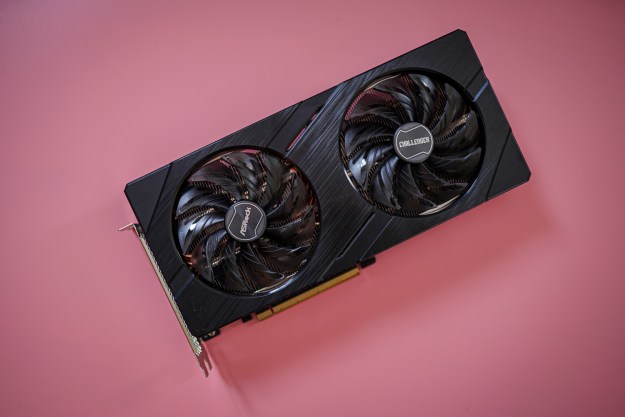Some benchmarks for Intel’s upcoming Arc Alchemist cards have leaked, showcasing a much-improved score over benchmarks that leaked in August. Although it seems Intel Arc Alchemist is coming along nicely, it probably won’t be the savior of the GPU shortage or a fierce competitor to AMD and Nvidia. At least initially, that is.
The latest benchmarks come from Geekbench (via Benchleaks) and show the flagship mobile variant of the Alchemist card earning an OpenCL score of 7,943. That’s around the same score as Intel’s UHD 750 graphics or an Nvidia GTX 560. Needless to say, it’s far below the bar set by graphics cards from the past few years.

This result doesn’t say much about Alchemist right now. First, it’s from a mobile configuration, so it doesn’t say much about add-in desktop performance, and it’s far below where it should be, likely on the back of poor driver optimization. Intel wouldn’t release a graphics product in this state, so you shouldn’t take the result as an indication of performance.
Still, some other leaks show that performance may not be at the level some people are expecting. Moore’s Law is Dead, a YouTube channel known for leaking hardware information, has said that performance for the flagship desktop card is around an RTX 3060 right now. At the moment, it’s too soon to say if it will reach the levels of an RTX 3070.
The leaker says it’s hard to say where performance will be at when the card releases because “the drivers are in a horrible state.” To be clear, the leaker suggests that the bar is at least an RTX 3060, though the final Arc Alchemist cards could scale higher.
Playing the long game
Arc Alchemist is only one step in Intel’s graphics journey — there’s a reason the company released information about four generations instead of just one. Although leaks suggest that Alchemist will be competitive with midrange options from Nvidia and AMD, it likely won’t scale up to the levels of the RTX 3080 Ti or RX 6800 XT.
Graphics are nothing new for Intel.
Intel hasn’t confirmed anything, but Alchemist is likely a steppingstone. It’s a generation where Intel can prove its prowess in gaming graphics, establish features like XeSS and real-time ray tracing, and work on delivering drivers that are optimized for the latest games. The generation likely won’t compete with the flagship competition, and it probably isn’t intended to do so.
It’s worth noting that graphics are nothing new for Intel. The company has been producing integrated graphics chips for years, so it’s not like Team Blue is starting from scratch. Intel is, however, new to gaming desktop graphics. In that space, Intel is starting at a market share of zero, and it’s likely well aware that building up a customer base will take time.
Alchemist is the first step, but it won’t be the last. For the first-generation cards, Intel is likely aiming toward comparative performance that stands up to Nvidia and AMD, not performance that can put flagship cards in the ground.
Shortages still apply

Getting more graphics cards out is good for everyone — GPUs are still obscenely expensive, and prices don’t seem to be dropping. Arc Alchemist won’t solve the GPU shortage. Although Intel is an advantageous position with its manufacturing capacity and breadth, shortages and price spikes of components will still apply.
Intel has announced that it’s using chipmaker TSMC to manufacture Alchemist, which is the same company that has been producing AMD RX 6000 cards for nearly a year. We still have many months before Alchemist cards are here, but warnings from executives at major tech companies suggest that component shortages will be in full swing by then.
Come next year, Intel will be fighting an uphill battle to establish itself during one of the lowest points for graphics cards. Although Alchemist cards will introduce GPUs into the market that otherwise wouldn’t exist, we suspect that they’ll still fall victim to the high prices and limited availability that’s plagued the graphics card market for nearly a year.
More to come

Given the rumors currently circulating, Intel Arc Alchemist looks like it will fall somewhere between an RTX 3060 and RTX 3070 Ti, but we’re not sure just where right now. At least for the first generation of Arc cards, it looks like Nvidia and AMD will remain the go-to brands for high-end gaming performance.
Just because Intel won’t be the savior to the GPU shortage, or a flagship competitor to AMD or Nvidia, doesn’t mean you should discount it. Intel looks to be tackling the graphics problem from the middle, starting with midrange cards and expanding outward as it establishes a foothold in the desktop graphics market.
There’s a lot we still don’t know about Alchemist. Intel hasn’t detailed anything about performance yet, and pricing will play a critical role in how the cards stack up to the competition. Although it doesn’t look like we’ll get flagship performance, there are still a lot of reasons to be expected about Arc Alchemist.
Editors' Recommendations
- 5 cheap graphics cards you should buy instead of the RTX 4060
- AMD’s graphics card sales just took a nosedive
- I tried the Apple Vision Pro. Here’s why it won’t replace my iPhone
- Intel may be throwing away an important opportunity
- Intel claims up to 268% gaming boost with latest Arc graphics drivers



